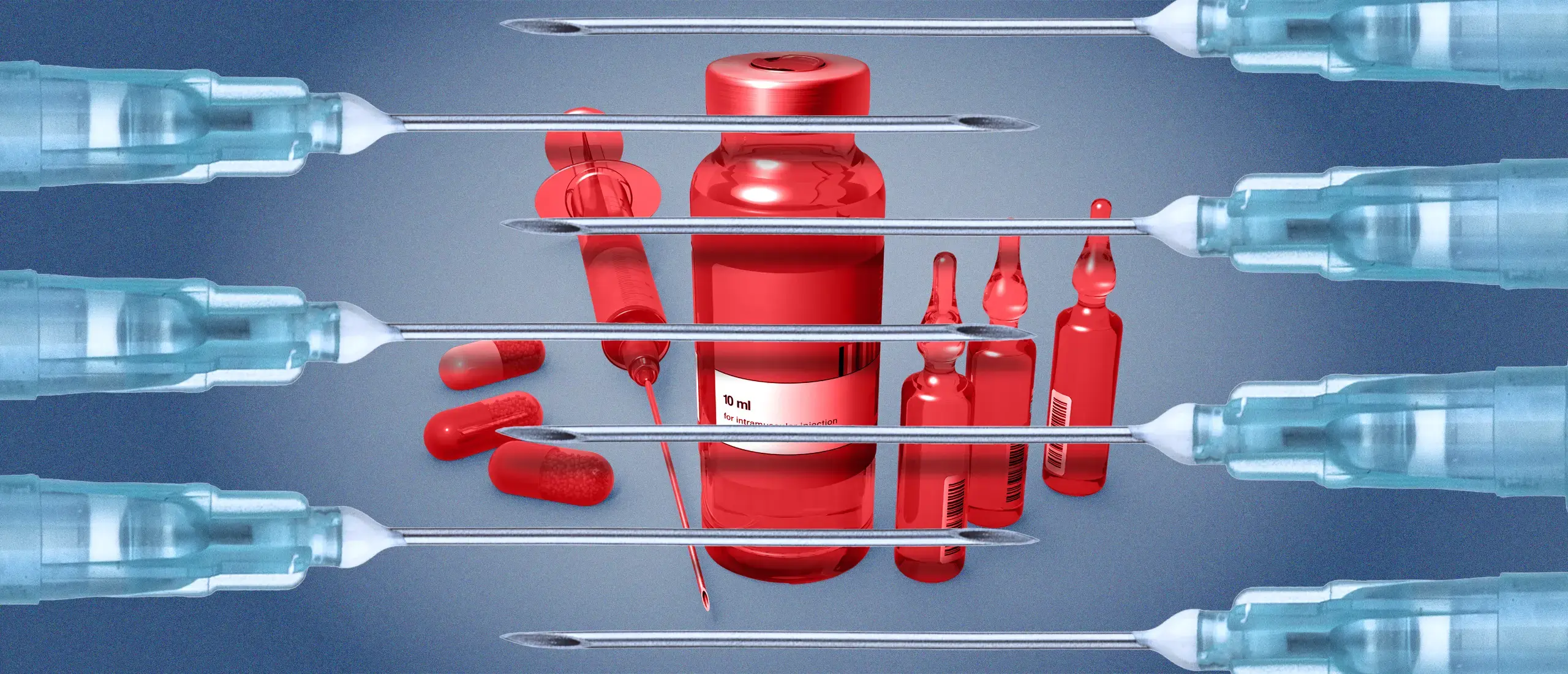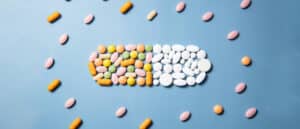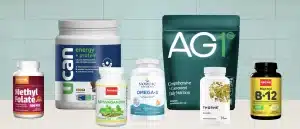The FDA Just Banned 17 Peptide Treatments
- By Rebekah Harding
- February 29, 2024
30-Second Takeaway
The FDA banned compounding pharmacies from selling certain peptide therapies. While unrestricted vendors may continue selling these treatments, this route is risky. Here’s what to do if your protocol was impacted by the new regulations.
P
eptide therapy has recently gone mainstream thanks to popular peptides like semaglutide (Ozempic) and tirzepatide (Mounjaro). But bodybuilders, longevity buffs, health podcasters, and biohackers are reeling after the FDA recently banned 17 other popular peptides.
Peptides are a chain of amino acids that your body uses to perform essential functions (1). When injected or ingested, they can deliver longevity benefits including weight loss, muscle gain, brain health, libido, hormone management, and more.
But not all peptides are as well researched—which is one of the primary reasons why the FDA recently released new regulations limiting the sale of certain prescription peptide treatments. (There are still black market peptide pushers that sell the now-banned peptides without a valid prescription—but this route is risky and not recommended).
Peptides that are well studied and have a generic form were deemed okay by the FDA. However, peptides with little clinical research were on the chopping block due to concerns of impurities and dangerous side effects linked to compounded treatments.
Unlike regular pharmacies that sell pre-manufactured drugs, compounding pharmacies can put prescribed drugs into custom topical treatments, injectables, flavored liquids, and more at specified doses.
However, compounded peptides run the risk of variability between treatments. Hence, the FDA cracking down on compounding pharmacies mixing peptides that the agency deems under-researched or dangerous.
While the ban is immediate, compounding pharmacies can still run through their current stock of the now-regulated peptides.
Curious if your go-to peptide therapy is on the list? The following peptides were affected by the FDA ban. Plus, alternatives for treatment if your protocol was impacted.
Peptides Impacted by FDA Restrictions
AOD-9604
AOD-9604 is beloved by bodybuilders for its purported ability to speed up metabolism, burn stubborn fat, and amp muscle growth by boosting human growth hormone and curbing insulin resistance (2).
Human growth hormone, or HGH, is released by the pituitary gland to promote height in puberty, muscle growth, and bone strength (3). As you age, your HGH levels fall (4)—which makes AOD-9604 popular among people looking to boost muscle
Why it was included in the FDA ban
AOD-9604 was cited as having a “risk for immunogenicity (the ability to trigger a negative immune reaction), peptide-related impurities, and limited safety-related information.”
BPC-157
BPC-157, aka the “magic peptide,” is a biohacking fan-favorite for its potential to improve brain function, boost gym gains, improve joint pain, and heal gut inflammation (5, 6, 7). Animal studies suggest this peptide may also promote angiogenesis—the process in which your body makes more blood vessels (8).
Why it was included in the FDA ban
The FDA cites “risk for immunogenicity, peptide-related impurities, and limited safety-related information” as reasons for the BPC-157 ban.
BPC-157 is still available as an oral pill. BPC-157 is one of the only peptides that can survive the acidic environment in your stomach (9), so oral treatment is likely very effective.
Expert Swaps:
Pentosan polysulfate is an injectable peptide that has been shown to improve osteoarthritis and other joint pain (10). This peptide may work as an alternative if you primarily take BPC-157 for joint health.
Larazotide is a peptide that may reduce gut permeability by strengthening your gut lining (11). Ask your doctor about using this peptide as a replacement if you take BPC-157 to promote gut health.
CJC-1295
At a glance, CJC-1295 seems like an all-around longevity-supporting peptide, touting better sleep, increased muscle mass and weight loss, boosted cognitive and immune function, and slowed skin aging (12, 13, 14) in animal studies.
Why it was included in the FDA ban:
According to the FDA, CJC-1295 carries a risk for increased heart rate and cardiac events. Plus, compounded CJC-1295 runs the risk of peptide impurities and harmful immune responses, according to the agency.
Expert Swap:
Like CJC-1295, Sermorelin also promotes healthy body composition by increasing growth hormone (15).
DIHEXA
DIHEXA is a blood-brain barrier-penetrating peptide commonly used by people concerned about their risk for degenerative diseases like Alzheimer’s, dementia, and Parkinson’s (16). Users claim that DIHEXA increases mental stamina, improves problem-solving skills, manages depression, and boosts memory.
Why it was included in the FDA ban
While animal studies suggest that DIHEXA may tout these brain benefits (17), the FDA says it “has not identified any human exposure data.” Meaning: The safety and efficacy of DIHEXA for humans is still up in the air.
Expert Swaps:
Cerebrolysin is a brain recovery peptide that has shown promise in staving off neurodegenerative diseases like Alzheimer’s (18). (Fibroblast Growth Factor) may improve memory (19).
DSIP
If you can’t get to sleep, you may have stumbled across DSIP in a biohacking subreddit. DSIP is thought to increase production of GABA (20)—a neurotransmitter that slows brain activity, promotes relaxation, and increases time spent in deep sleep. Research shows that increasing GABA levels may help improve insomnia (21).
Why it was included in the FDA ban
Research on DSIP in humans is still lacking, per the FDA. However, you can purchase GABA supplements at your local health foods store.
Epitalon
Epitalon is a synthetic version of the natural peptide Epithalamin, which is produced by the pineal gland (22). Epitalon may regulate the pineal gland, which can bump your production of sleep-supporting hormones serotonin and melatonin.
Some research also suggests that Epitalon can also lengthen your telomeres—the caps at the end of your chromosomes that shorten with age (23). Telomere length is a key marker used to calculate cellular aging, and maintaining longer telomeres is thought to slow down cellular aging.
Why it was included in the FDA ban
Compounded Epitalon was banned because of a potential for peptide impurities and immune reactions. Epitalon is still available in pill form.
GHK-Cu
GHK-Cu, or copper peptides, are a combination of tripeptide Glycyl-L-Histidyl-L-Lysine and copper ions. Research suggests that this peptide may stimulate collagen production—a protein that helps maintain skin elasticity and firmness—which has boosted its popularity in anti-aging skincare treatments (24). GHK-Cu is also thought to be a powerful antioxidant, which may support wound healing, reduce inflammation, and enhance skin regeneration.
Why it was included in the FDA ban
Injectable GHK-Cu was banned because of a high risk for immune reactions and impurities during the compounding process. GHK-Cu is still available in topical skincare products.
Ipamorelin
Ipamorelin is a growth hormone-releasing peptide (GHRP) commonly used to stimulate muscle growth and improve post-workout recovery and metabolism (25).
Why it was included in the FDA ban
In the FDA release, the agency cites a study in which serious adverse events including death occurred when patients were given ipamorelin through an IV.
KPV
KPV—a relatively new anti-inflammatory peptide—is sought out for its ability to speed up healing, curb infection, and axe chronic inflammation (26). For example, one Reddit user claims that KPV treatment helped curb symptoms of their mast cell disease and histamine reactions.
Why it was included in the FDA ban
There have been no human trials on KPV to date.
LL-37
LL-37 is a naturally occurring antimicrobial peptide which some research suggests might help your body fight off harmful bacteria, viruses, and fungi (27). This peptide has also been studied as a potential anti-inflammatory treatment, and research suggests it may show promise in treating skin conditions like rosacea (27).
Why it was included in the FDA ban
Nonclinical research findings suggest that LL-37 could negatively impact male fertility. Plus, LL-37 could be protumorigenic—meaning it could cause tumors to develop—in some tissues.
Melanotan II
Melanotan II mimics the hormone alpha-melanocyte-stimulating hormone (α-MSH), which controls skin pigmentation (28). People gravitate towards this peptide to deepen their tan.
Why it was included in the FDA ban
Melanotan II was banned for reported adverse effects like melanoma skin cancers, posterior reversible encephalopathy syndrome (a seizure and headache disorder), sympathomimetic toxidrome (symptoms of poisoning), and priapism (dangerous, prolonged erections).
MOTS-C
MOTS-C may boost metabolism and promote muscle repair. This peptide has also shown promise in boosting mitochondrial function and cellular energy (29).
Why it was included in the FDA ban
Research has not yet proven MOTS-C to deliver the above benefits. However, the agency cites initial findings that show that it may be used for future treatment of age-related conditions and metabolic disorders.
Ibutamoren
Ibutamoren, often called MK-677, is a selective growth hormone secretagogue receptor (GHSR) agonist, meaning it stimulates the release of the muscle and bone-supporting growth hormone that your body naturally makes (30).
Why it was included in the FDA ban
The FDA cites significant safety “risks due to the potential for congestive heart failure in certain patients” seen in a clinical trial that was terminated.
Selank
Selank is an anti-anxiety and nootropic (brain boosting) peptide being researched for its ability to balance neurotransmitters like serotonin, dopamine, and norepinephrine (31). These neurotransmitters play a role in regulating mood and appetite.
Why it was included in the FDA ban
Selank has a high risk of immune reactions and impurities during the compounding process, according to the agency’s press release.
Semax
Semax is derived from adrenocorticotropic hormone (ACTH), which regulates cortisol and androgen production. Studies suggest that Semax may boost memory, attention, and learning by modulating neurotransmitter activity in the brain (32). Plus, this peptide has also shown neuroprotective properties by lowering oxidative stress and improving overall brain health in animal studies (33).
Why it was included in the FDA ban
Semax has a high risk of immune reactions and impurities during the compounding process.
Expert Swap:
PE 22-28 is a peptide commonly used to improve depression, boost memory, and prevent stroke (34). Discuss this peptide with your prescriber if you take Semax.
Thymosin Beta 4
Thymosin Beta 4 is a naturally occurring peptide that studies suggest may help with tissue repair and regeneration (35). Initial research has found that Thymosin Beta 4 has anti-inflammatory properties and may boost heart health (35).
Why it was included in the FDA ban
The agency cited a lack of human trials and the risk for immune reactions and peptide impurities with injectable Thymosin Beta 4. The pill version of the peptide wasn’t impacted by the ban.
Thymosin Alpha 1
Thymosin Alpha 1 is a synthetic version of the thymic peptide that has shown promise in boosting immune health (36). Some research shows that Thymosin Alpha 1 may increase your body’s natural T-cell production, which helps you fight infections and diseases (36).
Why it was included in the FDA ban
Injectable Thymosin Alpha 1 may be linked to immune reactions.
What If I’m Already Taking a Banned Peptide?
If you’re already taking one of the peptides impacted by the new FDA regulations, take these steps to preserve your peptide therapy results.
1. Talk to your provider about alternatives
The FDA hasn’t banned all peptides, and many of the regulations only cover compounded peptide treatments. You may be able to continue treatment with a few tweaks in the administration method.
For example, many oral versions of peptides (like BPC-157 and Thymosin Beta 4) are not banned—it’s just the injectables. Talk to your prescriber about a replacement oral version or injectable peptide that offers similar benefits.
2. Be wary of compounds from unregulated pharmacies
While the FDA has banned compounding pharmacies from making certain peptides, there are other pharmacies—dubbed ‘unregulated pharmacies’—that are not regulated by the government. These pharmacies may still manufacture banned peptides—but be wary of quality and safety if you are intent on going this route.
Products from some unregulated pharmacies may be tainted with heavy metals like mercury.
If you do decide to get a peptide prescription through an unregulated pharmacy, ensure it has favorable reviews and a recent certificate of authenticity (COA).
You can also ask the pharmacy if you can send the peptide to a lab to verify the contents. If they give you hesitancy with that, then that’s a red flag.
References
1. Forbes, et al (2023). Biochemistry, Peptide.
2. Ng, et al (2000). Metabolic studies of a synthetic lipolytic domain (AOD9604) of human growth hormone.
3. Brinkman, et al (2023). Physiology, Growth Hormone.
4. Garcia, et al (2019). Growth Hormone in Aging.
5. Vukojevic, et al (2022). Pentadecapeptide BPC 157 and the central nervous system.
6. Lee, et al (2021). Intra-Articular Injection of BPC 157 for Multiple Types of Knee Pain.
7. Sikiric, et al (2016). Brain-gut Axis and Pentadecapeptide BPC 157: Theoretical and Practical Implications.
8. Hsieh, et al (2017). Therapeutic potential of pro-angiogenic BPC157 is associated with VEGFR2 activation and up-regulation.
9. Seiwerth, et al (2021). Stable Gastric Pentadecapeptide BPC 157 and Wound Healing.
10. Liu, et al (2023). The effect of pentosan polysulfate sodium for improving dyslipidaemia and knee pain in people with knee osteoarthritis: A pilot study.
11. ScienceDirect. Larazotide.
12. Alba, et al (2006). Once-daily administration of CJC-1295, a long-acting growth hormone-releasing hormone (GHRH) analog, normalizes growth in the GHRH knockout mouse.
13. Teichman, et al (2006). Prolonged stimulation of growth hormone (GH) and insulin-like growth factor I secretion by CJC-1295, a long-acting analog of GH-releasing hormone, in healthy adults.
14. Gautam, et al (2009). Neuronal M3 muscarinic acetylcholine receptors are essential for somatotroph proliferation and normal somatic growth.
15. Walker, et al (2006). Sermorelin: A better approach to management of adult-onset growth hormone insufficiency?
16. Sun, et al (2021). AngIV-Analog Dihexa Rescues Cognitive Impairment and Recovers Memory in the APP/PS1 Mouse via the PI3K/AKT Signaling Pathway.
17. Weiss, et al (2021). Stem cell, Granulocyte-Colony Stimulating Factor and/or Dihexa to promote limb function recovery in a rat sciatic nerve damage-repair model: Experimental animal studies.
18. Gauthier, et al (2015). Cerebrolysin in mild-to-moderate Alzheimer’s disease: a meta-analysis of randomized controlled clinical trials.
19. Zellinger, et al (2014). Impact of the Neural Cell Adhesion Molecule-Derived Peptide FGL on Seizure Progression and Cellular Alterations in the Mouse Kindling Model.
20. Tukhovskaya, et al (2021). Delta Sleep-Inducing Peptide Recovers Motor Function in SD Rats after Focal Stroke.
21. Hepsomali, et al (2020). Effects of Oral Gamma-Aminobutyric Acid (GABA) Administration on Stress and Sleep in Humans: A Systematic Review.
22. Khavinson, et al (2020). AEDG Peptide (Epitalon) Stimulates Gene Expression and Protein Synthesis during Neurogenesis: Possible Epigenetic Mechanism.
23. Shammas (2012). Telomeres, lifestyle, cancer, and aging.
24. Pickart, et al (2018). Regenerative and Protective Actions of the GHK-Cu Peptide in the Light of the New Gene Data.
25. Sinha, et al (2020). Beyond the androgen receptor: the role of growth hormone secretagogues in the modern management of body composition in hypogonadal males.
26. Xiao, et al (2017). Orally Targeted Delivery of Tripeptide KPV via Hyaluronic Acid-Functionalized Nanoparticles Efficiently Alleviates Ulcerative Colitis.
27. Reinholz, et al (2012). Cathelicidin LL-37: an antimicrobial peptide with a role in inflammatory skin disease.
28. Gilhooley, et al (2021). Melanotan II User Experience: A Qualitative Study of Online Discussion Forums.
29. Mohtashami, et al (2022). MOTS-c, the Most Recent Mitochondrial Derived Peptide in Human Aging and Age-Related Diseases.
30. Liu, et al (2021). Structural basis of human ghrelin receptor signaling by ghrelin and the synthetic agonist ibutamoren.
31. Volkova, et al (2016). Selank Administration Affects the Expression of Some Genes Involved in GABAergic Neurotransmission.
32. Glazova, et al (2021). Semax, synthetic ACTH(4–10) analogue, attenuates behavioural and neurochemical alterations following early-life fluvoxamine exposure in white rats.
33. Sudarkina, et al (2021). Brain Protein Expression Profile Confirms the Protective Effect of the ACTH(4–7)PGP Peptide (Semax) in a Rat Model of Cerebral Ischemia–Reperfusion.
34. Djillani, et al (2017). Shortened Spadin Analogs Display Better TREK-1 Inhibition, In Vivo Stability and Antidepressant Activity.
35. Xing, et al (2021). Progress on the Function and Application of Thymosin β4.
36. Dominari, et al 2020). Thymosin alpha 1: A comprehensive review of the literature.















